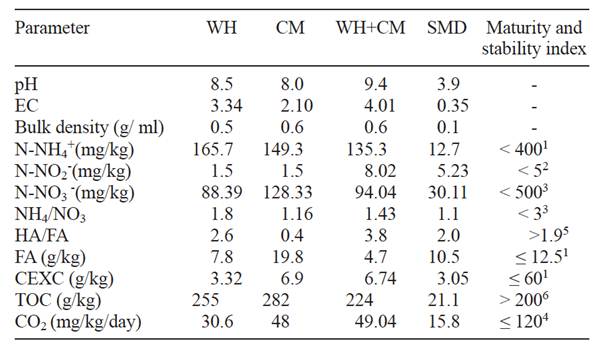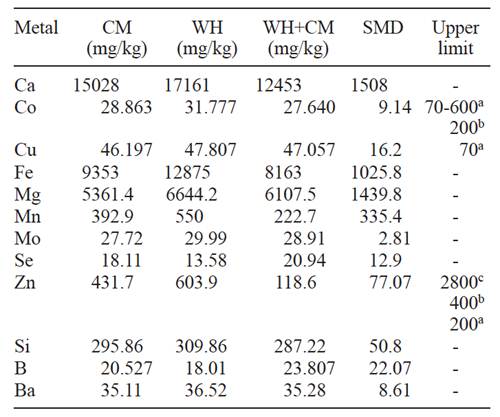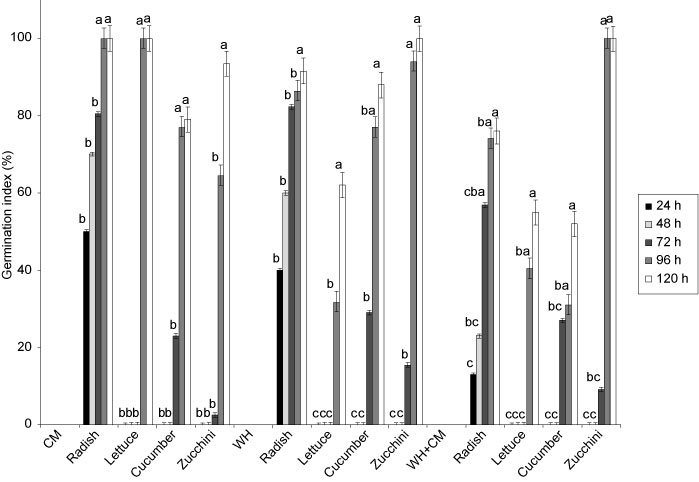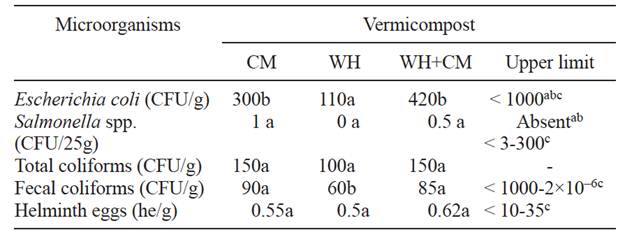INTRODUCTION
The water hyacinth (WH), Eichhornia crassipes, is an emergent plant of the family Pontederiacea and is considered an invasive plant because of its rapid population growth (Patil 2012). It tolerates intervals of pH, between 6-8, and grows rapidly when nitrogen levels are around 21 mg/L, phosphorus of 62 mg/L, iron of 0.6 mg/L, and at least 5 mg/L of calcium (Coetzee et al. 2007, Ruíz-Tellez et al. 2008). The WH is found in bodies of water with high nutrient levels (Malik 2007).
This aquatic weed has caused economic and environmental losses in many countries, because of its rapid growth it can obstruct the access to the pumps used for irrigation, causing water resources depletion, and the spreading of mosquitoes and flies which are vectors of a number of diseases (Ding et al. 2001). There are several ways to handle and control WH including mechanical, biological, and chemical methods. However, it is also used to produce valuable products, such as, biogas, compost and vermicompost (Malik 2007).
Vermicomposting is a biological method where worms such as Eisenia fetida, Eudrilus eugeniae or Lumbricus rubellus (Gajalakshmi et al. 2001, Gupta et al. 2007) are used for transforming organic waste into vermicompost. It has been reported that vermicompost is rich in nutrients and contain enzymes and hormones that stimulate plant growth and help them resist pathogens (Gajalashkmi and Abbasi 2004). However, vermicompost can have a large amount of salts, high electrical conductivity due to the origin from the raw material used, which can be a serious threat for sensible crops (Edwards and Bohlen 1996). The importance of using water hyacinth for vermicomposting is because this method stops its proliferation by eliminating its ability to reproduce (Malik 2007).
Stability and maturity of a vermicompost is important because it indicates when it is ready to be used as organic fertilizer or soil conditioner. One crucial analysis is the germination index that indicates indirectly if the vermicompost contains phytotoxic compounds or a large amount of salts that can damage plants (Barrena et al. 2014, Khan et al. 2014). The aim of this work was using water hyacinth to produce stable and mature vermicompost with Californian red worm in order to give an alternative management of this aquatic weed.
MATERIALS AND METHODS
Sampling site
WH was collected from three drains in the irrigation district 024, Ciénega de Chapala, in northeast Michoacán, México (19º 34´27´´ and 20º 16´37´´ N; 102º 43´16´´, 102º 32´53´´ W), at an altitude of 1525 masl (INEGI 2015).
The drains in the irrigation district had the following flora: Hydrocotyle vulgaris L., Scirpus spp., Pistia stratiotes L., Lemna minor L. Griff., Phragmites australis (Cav.) Trin. ex Steud., Typha domingensis Pers. and E. crassipes, the latter being the most abundant species (PCIMALC 2005).
Samples of WH were washed with potable water to remove sediment particles attached to the roots and leaves. The whole plant was cut in segments of 2 to 3 cm. Cattle manure (CM) was collected from a cowshed in Jiquilpan, Michoacán. The main physical and chemical characteristics of WH and CM are shown in Table I.
Table I Physical and chemical characteristics of raw materials for vermicompost

WH: water hyacinth, CM: cow manure
WH and CM were pre-treated by forming a pile of 50 cm and covering with a dark plastic bag (600 caliber). The pile was watered and turned every other day, during 20 days to eliminate volatile gases potentially toxic to E. fetida earthworms.
Experimental design
Three beds (1 m wide, 2 m long and 0.3 m high) were placed for each treatment, which were 1) WH, 2) CM and 3) a mixture of WH (50 %) and CM (50 %) (WH+CM). Each bed was treated with 1.5 kg of adult Californian red worms (E. fetida), and then was covered with a shadow mesh to prevent moisture loss and birds eating the worms. The moisture content was maintained and adjusted to 80 % on a daily basis. For survival index of earthworms, a random sample was taken using a framework of 0.5 m by 0.5 m each side, placed in the middle of the bed to eliminate the edge effect, at 20 cm of depth of the bed. Survival was calculated as the ratio between the number of organisms collected at the end of the experiment and the number of initial organisms (Allen 1990). After 110 days earthworms were separated from beds with specific traps. A sample was collected from each bed and then air dried at room temperature in the shade, grounded and stored in a plastic bag for later analysis.
Physical and chemical analysis
Each sample was analyzed for the following parameters: pH and electrical conductivity (EC) using distilled water in a 1:10 (w/v), total organic carbon (Nelson and Sommer 1982), total Kjeldah nitrogen (Bremner and Mulvaney 1982), moisture (Alef and Nannipieri 1995), oxidable organic carbon and CO2 (Sánchez-Monedero et al. 1996), inorganic carbon (Page 1982), cation exchange capacity (Uehara and Gillman 1981), finally, NH4 + and NO3 - were measured by colorimetric techniques (APHA 1988).
Germination index
The germination index was measured using seeds of R. sativus, Cucumis spp., L. sativa and C. pepo, according to Zucconi et al. (1981).
Microbiological analysis
Escherichia coli, total and fecal coliforms were determined in vermicompost with USEPA method 1680 (2010), Salmonella spp. with method 1682 (USEPA 1998), and helminth eggs as follows. The samples were mixed with buffered water containing a surfactant 0.1% (Triton X-100). Afterwards large particles were allowed to precipitate and the supernatant was decanted. The sediment was subjected to a density gradient centrifugation using magnesium sulfate (specific gravity 1.2 g cm−3). Small particles were removed by a second screening on a small mesh size screen (400 mesh US standard, 38 μm, stainless steel,) and proteinaceous material by an acid alcohol/ethyl ether extraction. The concentrate was subsequently incubated at 26 ºC for 10 days and microscopically examined for helminth eggs on a Sedgwick-Rafter counting chamber (Hausser Scientific, Horsham, Pa.) (USEPA 2003, Appendix I).
Metal analysis
A subsample of vermicompost was used to determine metals content (Ca, Co, Cu, Fe, Mg, Mn, Mo, Se, Zn, Si, B, Ba). 0.3 g of vermicompost were placed in polytetrafluoroethylene, flame retardant (PTFE-TFM) tubes and were digested in a microwave (Multiwave 3000 Perkin Elmer USA®) with 1.0 mL of concentrated hydrochloric acid (HCl), 9.0 mL of concentrated nitric acid (HNO3) and 2.0 mL of hydrogen peroxide at 30 % (H2O2). The metals were quantified by optical emission spectroscopy inductively coupled plasma (ICP-OES model Optima 4300 DV, PerkinElmer Instruments USA®).
RESULTS AND DISCUSSION
A stable and mature vermicompost was obtained after 110 days and their chemical and physical properties are shown in Table II. Gupta et al. (2007) reported 147 days to obtain stable and mature vermicompost, while Gajalakshmi et al. (2001) reported six months. In our study, the shorter process time was due to the large amount of earthworms added to each bed. In each bed the survival index was 90 % ± 2, indicating that the earthworms adapted to the materials used and that the WH from drainages did not contain compounds that interfered with their development. This is in contrast with Singh and Kalamdhad (2013) who found a decrease in earthworm survival, being necessary to use a mixture of 25 % WH and 75 % cow dung. An increase in the percentage of WH in the mixture resulted in an increase in mortality of these earthworms (Gajakshmi et al. 2001, Gupta 2007, Zirbes et al. 2011). Pre-compost is necessary to avoid earthworm mortality (Mupondi et al. 2011).
Table II Maturity and stability indexes for vermicomposts obtained with vermicomposting process

1Bernal et al. (1998), 2ASCP (2001), 3TMECC (2010), 4Hue and Liu (1995), 5Iglesias-Jiménez and Pérez-García (1992), 6Lasaridi et al. (2006)
WH: water hyacinth, CM: cow manure, WH+CM: water hyacinth plus cow manure, SMD: Significance minimal difference (p ≤ 0.05)
HA/FA: humic acid-fulvic acid ratio, FA: fulvic acid, CEXC: cation exchange capacity, TOC: total organic carbon
The pH was slightly saline in the three vermicomposts. CM and WH had a pH of 8.5 and 9.4 respectively, and EC ranging from 3.3 to 4.01 dS/m, indicating important presence of salts which may have little impact on salt tolerant crops (Table II). These results of EC were similar to those reported by Cardoso and Ramírez (2001) with an EC of 4 mmhos/cmand a pH value of 7.2. Vermicompost produced with WH and biosolids is alkaline because the calciferous glands add calcium (Bollo 1999). However, Gupta et al. (2007) obtained a pH value of 7 after 147 days with vermicompost of bovine manure and WH.
Table III Metals in vermicompost

aSource: European Commission (2014), bSource: WRAP (2014), cSource: US Composting Council (TMECC 2010). SMD: Significance minimal difference (P ≤ 0.05), CM: cow manure, WH: water hyacinth, WH+CM: water hyacinth plus cow manure
WH has been considered a natural kidney for disturbed waters. It has been used as a biofilter of wastewater rich in organic and inorganic nutrients, as well as water contaminated with toxic metals and persistent organic compounds (Malik 2007). WH also takes salts from drainage water (Zhou et al. 2007, Singh and Kalamdhad 2013). Waters from the drainage system of Ciénega de Chapala are brackish (Silva-García et al. 2006), and CM has a large amount of salts as well (EC 5.5 dS/m), which explains the high values of pH and EC found in the vermicompost in this study.
The organic matter content and cation exchange capacity of the three vermicomposts were high (Table II), indicating that they are rich in nutrients and therefore suitable as organic amendment. It is known that vermicomposting of solid waste results in nutrient rich humus, produced by microorganisms in the digestive system of earthworms (Gajalashkmi and Abbasi 2004).
Vermicompost stability is related with the decomposition of organic matter (Bustamante et al. 2008), measured by mineralization of carbon and nitrogen (CO2 and NH4 +). The values of CO2 and NH4 + obtained indicated stability despite significant differences between treatments (Table II). The maturity indicates that vermicompost can be used as organic fertilizer to be microbiologically stable. The parameters that indicate maturity in compost are oxidizable organic carbon, C:N ratio and germination index (Sánchez-Monedero et al. 2001). For the oxidizable organic carbon and C:N ratio, there were significant differences between samples (Table II), these results indicate stability and maturity in the three treatments.
Germination index (GI) is one of the most important parameters for stability. The sensitivity of seeds to the phytotoxic compounds and salts was varied and the best response was the radish with germination at 24 h. In contrast, the other seeds had an adaptation phase and there was no germination in the first 48 h until the 72 h were reached. Vermicompost WH+CM, had lower rates of germination for all seeds, due to its high conductivity (Fig. 1). Zirbes et al. (2011) suspects that the phytotoxic compounds from WH are responsible for the low percentage in germination index.

Fig. 1 Germination index of different seeds with extracts of vermicompost CM: cow manure, WH: water hyacinth, WH+CM: water hyacinth plus cow manure. Bars with the same letter mean there are no significant differences (p ≤ 0.05)
The lettuce seeds are more sensitive to salts and phytotoxic compounds. In all the vermicompost the germination of these seeds was recorded until 96 h. Germination in vermicompost WH was 70 %, in WH+CM was 80 % after 120 h, and 100 % in CM. The above indicates that despite having different degrees of maturity, and no phytotoxic compounds, salts affect germination stage.
Vermicompost with WH had a low rate of GI with seeds of cucumber and lettuce compared with seeds of radish (Fig. 1). These results coincide with those from Zirbes et al. (2011), who found a low percentage of GI with vermicompost of WH. In contrast, zucchini seeds have one hundred % of GI despite the high EC of the WH vermicompost.
Mixed vermicompost WH+CM had a lower GI in most seeds compared with other treatments, likely because of the salt excess, and EC of 4.01 dS/m. Patidar et al. (2013) found a 60 % of GI for radish with a mixed vermicompost (WH + CM).
Metal concentrations in three vermicompost are shown in Table III. There were no significant differences among treatments, and most of the metals were in great concentrations (i.e. Ca 15028 mg/kg), except for B, Ba, Se and Mo. There is evidence that metals accumulate in WH. Singh and Kalamdhad (2013) found similar concentrations of Zn, Mn, Cu and Fe after 45 days of vermicomposting. Nevertheless, a high pH reduce bioavalibility of these metals (Ingelmo et al. 2012). The concentrations of Co and Cu in the three treatments were below the upper limits reported by the European Comission (2014) and WRAP (2014). Zinc was found within the upper limits of US Composting Council (TMECC 2010), but was higher for European Comission and WRAP. It is important to evaluate metals in compost because of the risks to the environment when using organic amendments with a high concentration of metals. Regulations about metals in compost exist in many countries except in México (Barrena et al. 2014, Mohee and Soobhany 2014).
The microbial quality of vermicompost is important because pathogens can cause damage to the health of those who handle this type of fertilizer. Microbiological results are shown in Table IV. Total and fecal coliforms and helminth eggs were present in low values in three vermicomposts (0.55-0.62 he/g). However, there are no regulations about the microbial content in compost. Results for E. coli were low in three vermicomposts and Salmonella was absent only in WH vermicompost according to the USEPA, European Commision, and WRAP regulations.
Table IV Microbial parameters of vermicomposts

aSource: European Commission (2014), bSource: WRAP (2014), cSource: US Composting Council (TMECC 2010). Rows with the same letter mean there are not significant differences (P ≤ 0.05). CFU: colony forming units, he: number of helminths eggs, CM: cow manure, WH: water hyacinth, WH+CM: water hyacinth plus cow manure
Hait and Tare (2011) found higher amounts of total and fecal coliforms, Salmonella and helminth eggs in vermicompost of sludge, in contrast with our low values. Interestingly, the British specification of quality compost for growth media requires the absence of such organisms (WRAP 2014). Care must be taken with handling vermicompost because it is not completely safe and can cause stomach diseases in susceptible individuals. Therefore, it is important to use proper management techniques with appropriate personal equipment.
CONCLUSION
Water bodies with WH problems can be managed by using the WH for vermicomposting, because it can produce a stable, mature and rich in nutrients vermicompost useful as organic fertilizer or soil improver. Besides, the whole process is carried out in a relatively short time: 110 days, including 20 days pre-composting and 90 days of vermicomposting. Vermicompost of WH has an important amount of metals and salts, however some seeds can thrive.











 nueva página del texto (beta)
nueva página del texto (beta)


